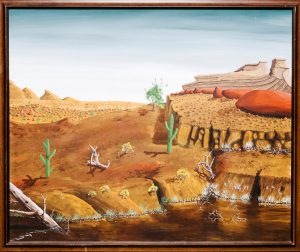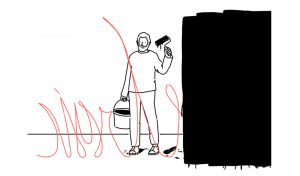 Last month, news emerged of a bizarre case in New York in which Peter Doig, a renowned painter denied having created the above painting. He didn’t have much to say when he was shown a picture of it – ‘Nice painting’, he said – ‘Not by me’. Since his paintings routinely sell for an upwards of $10 million, it is no surprise that Robert Fletcher, the owner of the painting filed a lawsuit against Doig. He claims damages of $5 million, as it was Doig’s disavowal that prevented Fletcher from selling the piece at an auction. This case, filed five years ago recently went to trial, and seems to only get more interesting at every stage. Apart from the unusual situation of an artist having to prove that a painting isn’t his, this case brings up the fascinating question of whether an artist is entitled to disavow a work under copyright law.
Last month, news emerged of a bizarre case in New York in which Peter Doig, a renowned painter denied having created the above painting. He didn’t have much to say when he was shown a picture of it – ‘Nice painting’, he said – ‘Not by me’. Since his paintings routinely sell for an upwards of $10 million, it is no surprise that Robert Fletcher, the owner of the painting filed a lawsuit against Doig. He claims damages of $5 million, as it was Doig’s disavowal that prevented Fletcher from selling the piece at an auction. This case, filed five years ago recently went to trial, and seems to only get more interesting at every stage. Apart from the unusual situation of an artist having to prove that a painting isn’t his, this case brings up the fascinating question of whether an artist is entitled to disavow a work under copyright law.
The facts of the case are quite confusing, with Doig and Fletcher both asserting two remarkably different factual scenarios with respect to the origin and sale of the painting. According to Fletcher, he was Doig’s parole officer in 1976 while Doig was incarcerated in the Thunder Bay Correctional Centre in Canada. He alleges that it was then that Doig sold him the painting for $100, and signed it ‘Peter Doige 76’. Doig, on the other hand – denies ever having been an inmate in the Centre, and stated that he lived with his parents in Toronto in 1976, before leaving for art school in England.
While Fletcher has no record of a Peter Doig as an inmate, he bases his arguments on an incomplete account of Doig’s teenage years. Doig’s legal team, on the other hand is said to have identified a man who might be the ‘real artist’ – Peter Edward Doige, a supposed artist who might have been an inmate in the Centre. While there is a very real possibility that Doig might succeed in proving that the painting is not his, it will be fascinating to see what the Court has to say of the painting’s authorship, should it be proved to be Doig’s by evidence. In that eventuality, the case would throw up the peculiar situation of an artist not being the final arbitrator of his painting, but a judge or a jury.
 This isn’t the first instance of artists disavowing their work, but perhaps the first in which they have been taken to court for it. Richard Prince and W. S Auden are among those who disavowed their earlier work, as noted by The Atlantic and The Huffington Post. If Doig succeeds in disproving his alleged authorship, the Visual Artists Rights Act, 1990 (‘VARA’), in Title 17 of the U.S Code provides authors the right to prevent the use of their name on visual art that they did not create – reaffirming Doig’s stand.
This isn’t the first instance of artists disavowing their work, but perhaps the first in which they have been taken to court for it. Richard Prince and W. S Auden are among those who disavowed their earlier work, as noted by The Atlantic and The Huffington Post. If Doig succeeds in disproving his alleged authorship, the Visual Artists Rights Act, 1990 (‘VARA’), in Title 17 of the U.S Code provides authors the right to prevent the use of their name on visual art that they did not create – reaffirming Doig’s stand.
The Indian Copyright Act (the ‘Act’), under Section 57 provides for ‘Author’s Special Rights’, or ‘moral rights’. The Act gives authors the right of attribution on their works, as well as the right to prevent others from distorting, or modifying their works in a manner prejudicial to their honour or reputation. However, unlike VARA, it does not contain the explicit provision for authors to prevent the use of their name on works that they did not create – raising the question of how Indian Courts would decide such a dispute if it were to occur in the country.
The Delhi High Court, in 2002 decided on Amar Nath Sehgal v. Union of India – and held that the pulling down, and dumping of a mural infringed the authors moral rights. Importantly, the Court gave moral rights a wide interpretation, noting that Section 57 would override the terms dictated by a contract of the assignment of the copyright. We have carried numerous posts on moral rights in the past, and I’d especially recommend Mrinalini’s three-part series. (Read here, here and here).
Considering the wide interpretation given to moral rights in the past, and the lacuna in law, it really would be interesting to see how an Indian Court would decide on this matter, should such a case arise. Let’s take a hypothetical example – What would be the legal stand taken if Kalman San painted a blackbuck deer, but claimed someone else did it? He could pretend he didn’t do it, or claim he no longer supports the reasons behind doing it, but can he legally disassociate his name with it? Probably not – unless he finds someone else to take the ‘credit’ of being the author, or prove that the blackbuck painted itself.
